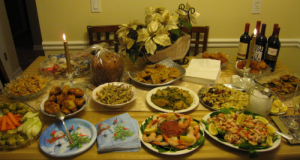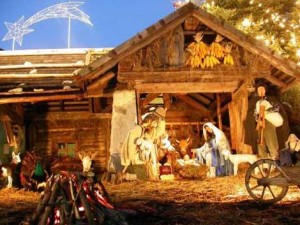
Italian Christmas
The Feast of the Immaculate Conception (Italian: Festa dell’Immacolata Concezione) on December 8 is a national holiday in Italy. Christmas decorations, including the presepe, as well as the Christmas tree, are put up on this day.
 Saint Lucy’s Day (Italian: Giorno di Santa Lucia) is celebrated as a Catholic holiday in Sicily and Northern regions of Italy on the Shortest day of the year which is December 13. Saint Lucy is the patron saint of the city of Syracuse better known as Santa Lucia as she is called in the traditional Neapolitan song. Evening candlelight processions called the parade of light are conducted and are followed by the Feast of St. Lucy. Sicilians pay tribute to a miracle performed by St Lucy during a famine in 1582. At that time, she brought a flotilla of grain-bearing ships to starving Sicily, whose citizens cooked and ate the wheat without taking time to grind it into flour. Thus, on St. Lucy’s Day, Sicilians do not eat anything made with wheat flour. Instead they eat cooked wheat called cuccia.
Saint Lucy’s Day (Italian: Giorno di Santa Lucia) is celebrated as a Catholic holiday in Sicily and Northern regions of Italy on the Shortest day of the year which is December 13. Saint Lucy is the patron saint of the city of Syracuse better known as Santa Lucia as she is called in the traditional Neapolitan song. Evening candlelight processions called the parade of light are conducted and are followed by the Feast of St. Lucy. Sicilians pay tribute to a miracle performed by St Lucy during a famine in 1582. At that time, she brought a flotilla of grain-bearing ships to starving Sicily, whose citizens cooked and ate the wheat without taking time to grind it into flour. Thus, on St. Lucy’s Day, Sicilians do not eat anything made with wheat flour. Instead they eat cooked wheat called cuccia.
 Christmas is celebrated in Italy in a similar fashion to other Western European countries, with a strong emphasis given to the Christian meaning of the holiday and its celebration by the Catholic Church, also reinforced by the still widespread tradition of setting up the presepe, a tradition initiated by Saint Francis of Assisi. It is quite common to attend midnight mass on Christmas Eve and practice the custom not to eat any meat. The dinner traditionally consists of seafood, with the Feast of the Seven Fishes, followed by typical Italian Christmas sweets, such as pandoro, panettone, torrone, panforte, struffoli, caggionetti, Monte Bianco or others, depending on the regional cuisine. Christmas on the 25th is celebrated with a family lunch, consisting of different types of meat dishes, cheese and local sweets.
Christmas is celebrated in Italy in a similar fashion to other Western European countries, with a strong emphasis given to the Christian meaning of the holiday and its celebration by the Catholic Church, also reinforced by the still widespread tradition of setting up the presepe, a tradition initiated by Saint Francis of Assisi. It is quite common to attend midnight mass on Christmas Eve and practice the custom not to eat any meat. The dinner traditionally consists of seafood, with the Feast of the Seven Fishes, followed by typical Italian Christmas sweets, such as pandoro, panettone, torrone, panforte, struffoli, caggionetti, Monte Bianco or others, depending on the regional cuisine. Christmas on the 25th is celebrated with a family lunch, consisting of different types of meat dishes, cheese and local sweets.
The ancient Christmas festival called Ndocciata is celebrated on Christmas Eve in Molise with a parade of torches leading up to the “Bonfire of Brotherhood”.
Traditions regarding the exchanging of gifts vary from region to region, as this might take place either on Christmas Eve or on Christmas Day. Presents for children are left underneath the Christmas tree either by Santa Claus (called Babbo Natale) or, according to older traditions, by Baby Jesus himself. In some regions children receive gifts earlier (at St. Lucy’s Day) or later (on Epiphany).
December 26, (St. Stephen’s Day, in Italian Giorno di Santo Stefano), is also a public holiday in Italy. Festivities extend to the end of the year and then to the Epiphany.
On the 6th of January (Epiphany, in Italian Epifania) decorations are usually taken down, and in some areas female puppets are burned on a pire (called “falò”), to symbolize, along with the end of the Christmas period, the death of the old year and the beginning of a new one. While gifts are now given at Christmas by an American style Santa Claus as well, Italy holds fast to its tradition of native gift-givers. On the eve of the 6th, la Befana, the good Epiphany witch, is thought to ride the night skies on broomstick, bringing good children gifts and sweets, and bad ones charcoal or bags of ashes. In other areas it is the Three Wise Men who bring gifts, especially oranges symbolizing gold, and chocolate symbolizing their kisses to good children. In some municipalities, most famously in Milan, the custom of the “Corteo dei Re Magi” (Three Kings Procession) is elaborately celebrated with a parade welcoming the Wise Men, and the passing out of sweets. In other places, such as Treviso the day is celebrated with bonfires, the sparks of which are said to predict the future of the new year.